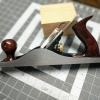Hi folks, I haven't posted too much here, but I sure have learned a lot from this site. Hoping someone can help with a question.
I'm making a 50" round solid walnut table top that is 11/2 thick. It's too heavy to cut the diameter on my band saw, so I plan to rough cut it with a jigsaw and finish with a circle cutting jig and my router. I have a 1/2 inch carbide upcutting spiral router bit that will cut up to 2" in length. These bits are expensive, so I wanted to know how much depth of cut I can take on the full 1 1/2 thickness of the table. I'm only planning to leave about 1/16 inch of stock to remove, but of course with a jig saw it will be irregular and probably not square with the faces of the table. Your suggestions would be appreciated.
Dave.




 Reply With Quote
Reply With Quote






